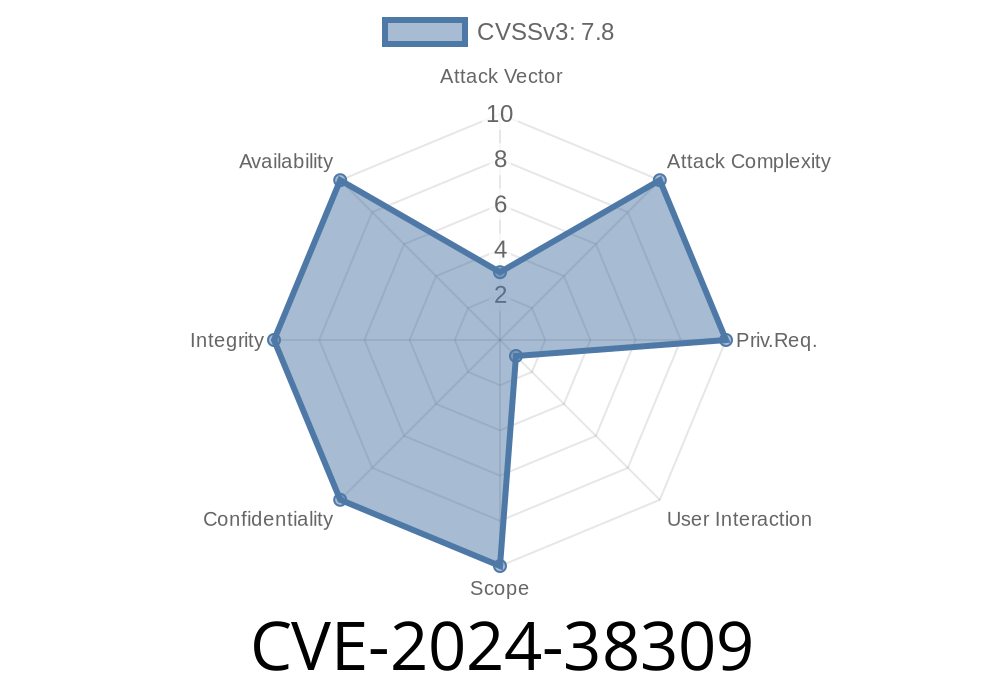CVE-2024-38309 covers serious stack-based buffer overflow vulnerabilities present in the following popular human-machine interface (HMI) and SCADA products by Fuji Electric:
TELLUS Lite (v4..19. and earlier)
If a user merely opens a maliciously crafted project file in any of these applications, an attacker could leak sensitive information from memory or execute arbitrary code with user privileges. This vulnerability is particularly risky in industrial environments where HMI/SCADA software interfaces directly with operational technology.
In this deep dive, we walk through details, a simplified attack scenario, plus practical mitigation steps tailored for technical teams.
What is a Stack-Based Buffer Overflow?
A *stack-based buffer overflow* happens when a program writes more data to a buffer (a temporary data storage area) located on the stack than the buffer can hold. This can overwrite adjacent stack variables, including the function's return address, potentially allowing attackers to control the program flow — often, to execute malicious code.
Here's a conceptual, vulnerable C code snippet to illustrate
void load_project(const char *filename) {
char buffer[256];
FILE *f = fopen(filename, "r");
if (!f) return;
fread(buffer, 1, 1024, f); // Unsafe: can overflow buffer!
fclose(f);
}
If the file is larger than buffer, extra data will overflow into adjacent memory.
TELLUS Lite: 4..19. and earlier
Trigger Condition:
All it takes to exploit this vulnerability is for the user to open a specifically crafted file (like a .prj project file, or similar supported format) with one of these applications. No special privilege or user interaction beyond that is needed.
Confidentiality: Memory leaks may expose sensitive process or configuration data.
- Integrity/Availability: The application can crash (denial of service).
- Arbitrary Code Execution: An attacker can execute malware with the user's privileges, possibly leading to deeper network compromise.
Exploit Scenario
Let’s walk through a plausible attack scenario using a buffer overflow in the file parsing routine.
Step 1: Crafting the Malicious Project File
Attackers analyze the project file format and create a section with an overly long value, exceeding any validation checks in the application’s parser.
Example (pseudo format)
[HEADER]
Name=AAAA...AAAA (512 'A's, far beyond normal length)
...
Attacker sends file to a plant operator or uploads to a shared engineering resource.
- Target opens file in V-SFT/TELLUS/TELLUS Lite.
Step 3: Achieving Code Execution (Code Snippet Example)
For a real-world exploit, the buffer overflow could be abused to run a "shellcode" — let's conceptually see how malicious data can overwrite a return address.
Assume the stack looks like
[... legitimate buffer ...][EIP return addr][...]
The attacker fills the buffer to overwrite EIP with the address of their shellcode, included in the file:
# Python code to generate exploit file (conceptual, doesn't target the real app)
buffer = b"A" * 264 # Fill buffer
eip = b"\xef\xbe\xad\xde" # Overwrite EIP (Return address)
shellcode = b"\x90" * 16 + b"\xcc" * 32 # NOP sled + payload example
with open('exploit.prj', 'wb') as f:
f.write(buffer + eip + shellcode)
When the file is opened, execution flow may jump to the attacker’s shellcode placed right after the overflow region.
> Note: Actual offsets and shellcode depend on binary specifics, which should be responsibly disclosed.
1. Upgrade Immediately
Fuji Electric released fixed versions after June 2024. Upgrade to:
Limit access to engineering stations.
- Restrict outbound access from HMI/SCADA workstations.
Monitor for abnormal application crashes.
- Use EDR/AV tools to catch suspicious process activity, e.g., cmd.exe launches from HMI application paths.
Responsible Disclosure & References
- Vendor Advisory: Fuji Electric Security Info (EN)
- CVE Entry: CVE-2024-38309 at NIST NVD
- ICS-CERT Advisory: https://www.cisa.gov/news-events/ics-advisories/icsa-24-173-01
Summary
CVE-2024-38309 presents a high-severity risk for industrial environments using V-SFT, TELLUS, or TELLUS Lite. Exploitation is simple: just opening a crafted file is enough for attackers to execute code or steal information. The only effective fix is to upgrade to the latest software versions and treat all project files as potentially dangerous until then.
Stay safe: Patch your systems and educate your users.
*Original research and analysis by ChatGPT, June 2024.*
Timeline
Published on: 11/28/2024 03:15:15 UTC
Last modified on: 11/29/2024 21:15:05 UTC
